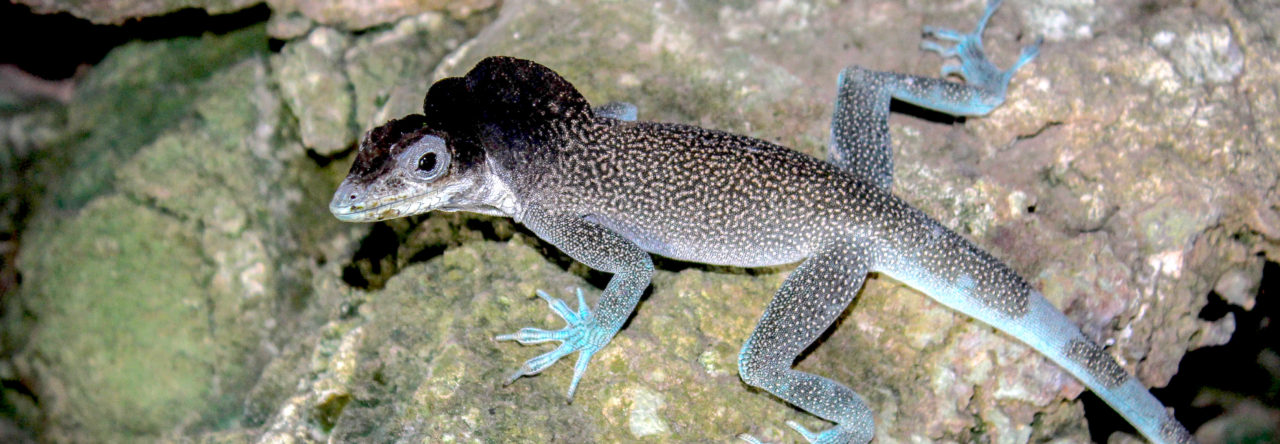
Photo by Janson Jones
Look at this poor fellow. Over on Phostracks, Janson Jones describes him and his demeanor thusly:
“Still, the most compelling characteristic of this anole was its passiveness. It wasn’t dead. Far from it, actually. The anole actively watched me, tracking me with its eyes. Still, when I rolled the lizard on its back, it just laid there like a puppy wanting a belly rub. Except for two or three miserable feeble attempts at escape, this anole was entirely passive (and clearly in need of a good dinner). It was just worn the hell out and in dire need of a vacation.
I placed the anole on the side of an unpopulated tree trunk to see if it could or would hang on (see image bottom left; image is rotated 90 degrees). No problem. It did just fine. It even moved around a bit. Then, when I started creeping back close again, nothing. It just sat there. Passive.
So, to quote Diondre Cole, “What’s up with that?” Any ideas? Any opinions? Any speculations?”
For more photos and entertaining description, check out the full post.
- Evolution in Real Time on Lizard Island - March 23, 2025
- Spider Snags Adult Anolis osa - March 22, 2025
- An Homage to the Green Anoles of New Orleans - March 21, 2025


Skip Lazell
What was the ambient temperature?
Janson
Skip, it was a good, warm run in south Florida that week — despite the sharp cold fronts we’ve had here and there this year. On 21 March 2015, the Low was 68 at night and High was 86. Most of my run at Matheson Hammock this day was between 10am and noon, so mid-to-upper 70s seems about right as I recall.
Of note, there were many anoles (A. cristatellus, A. sagrei, A. carolinensis, and A. distichus) active, alert, and extremely mobile at the same time — so it wasn’t an overall chill-factor across the population. The Agama africana were extraordinarily active as well — more so than I’ve seen them be in the past (that’s my next post). I did not, however, see *any* Iguana iguana, Basiliscus vittatus, or Anolis equestris — three other fairly common species around this area in the past. That being said, I didn’t so much scaling of trees to find the knights… heh.
Are parasitically infected A. cristatellus more sensitive to temps? Maybe this anole had more difficulty warming up from the night before with thanks to the parasitic infection?
Skip Lazell
Wow! Good question re parasites: beyond me… Skip
Armando Pou
Hi Janson, It may well be a parasite as skip noted, or it could have just been beaten up to the point of exhaustion. Matheson hammock is visited by families with kids and kids like to catch and play with lizards. That lump may be a parasite or it could be a rib/organ, pushed out towards the surface of the skin after being tossed in the air or to the ground a dozen times. After the kid finished tormenting it, maybe mom or dad told him, “now Jimmy (or Jaime) lets go put him back in the trees.” Of course this is all just speculation in fun; however, a metabolic condition that I have observed in all reptiles is a form of muscle fatigue due to lactate accumulation. From small lizards to large pythons and crocodilians, reptiles that are forced to endure a significant amount of handling, fatigue and completely collapse. Some of these animals if they continue to be handled eventually stress and die. However, many times given time to recuperate they bounce back and heal. Reptilian anatomy is fascinating; they can survive wounds that would outright kill a mammal or bird. If your little friend survives, chances are pretty good that he will never be caught again by an overactive kid and will flee at first sight.
Best regards,
Armando
Janson
Thanks, Armando! One note: This individual had two such lumps (not very clear in the photos), and I’ve seen quite a few other individuals (A. cristatellus) in this same area with the same lumps in appearance (though some were on the lower neck/jawline) in the past few years. It’s certainly not a one-off, isolated thing. Also of note, I can’t remember seeing any A. sagrei (or any other Anolis) in this area with the same degree of, um, lumpage. Heh. Though this anole had likely taken some battle damage too (the tail or lack of it being an indicator), this didn’t strike me as a simple matter of overhandling. Those lumps were pretty darn dramatic! Not something I usually see in Floridian anoles (meaning anoles I see in Florida, native or introduced). If your stress angle applies, maybe A. cristatellus is more pressured and stressed than the other species in this area?
Armando Pou
That is very interesting, then it is likely as skip noted at parasite that may just target A. cristatellus. The only lumps I can recall on any anole were usually around the jaws and face. This was particularly true in A. carolinensis/porcatus. In flowering palms I have seen them take not only pollen and nectar, but also the occasional bee (some stingless – others not). On occasion, I’m sure this backfires; it doesn’t seem to kill the anole though.
Armando Pou
Sorry Skip, I don’t mean to keep typing your name as “skip” there must be some autocorrect glitch on my computer.